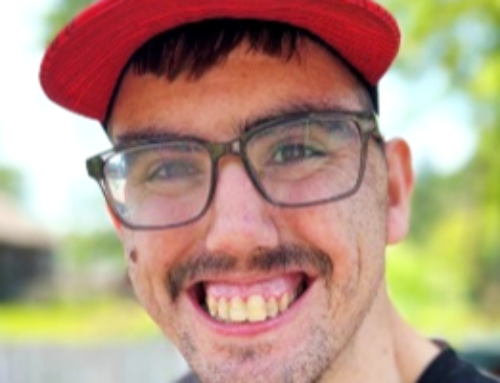
Disability and the Way of Jesus: Holistic Healing in the Gospels and the Church was recently released by InterVarsity Press Academic, written by Bethany McKinney Fox. You can pick up a copy here.
Over the past few years I have had the privilege of getting to know Dr. Bethany McKinney Fox through time spent at the Summer Institute on Theology and Disability, online networks, and most recently through her newly-released book on healing, disability, and Jesus. Bethany has an enjoyable and quirky sense of humour, loves to laugh, connects well and quickly with others, and has a real passion for seeing the Church become what it is called to be in communion with people with disabilities. Dr. Fox also has an insightful and probing mind, which makes her book a fascinating read. In Disability and the Way of Jesus, Fox delves into seven “marks of healing,” but covers much more through the pages of this book. It is multi-faceted in its grasp of theology, practical application, and personal stories.
It can be tricky to respectfully write on the topic of disability without having a visible or disclosed disability. We must always hesitate before telling someone else’s story. This book addresses that concern by inviting people to tell their own stories related to healing, with personal accounts sprinkled throughout the pages. These stories provide an “intermission” of sorts within the more theological or biblical reflection, and emphasize the real-world impact that one’s perspective on healing can have. Olusola John Gundola, for instance, offers a poignant memory of coming home from healing services in Nigeria, “despondent because, as my parents were told, they lacked sufficient faith for their son to be healed” (61).
Dr. Fox does emphasize stories of people who perhaps have not been “healed” in the traditional sense of their physical or intellectual disability, but she does not do so because she doesn’t believe that God can heal people in this way. Rather, as she makes clear, “this kind of individual, bodily transformation is how many people in the modern West already tend to think about healing” (7). This book seeks to expand our understanding of healing beyond constrained notions of medical or divine “cure.”
Analogical Imagination
Dr. Fox engages a mode of “analogical imagination,” which draws on Walter Brueggemann to “present an alternative vision and invite people into a new way of being.” In a nutshell, the way that we have traditionally thought of God’s healing – although a seeming miraculous and divine mode of intervention – has not been big enough. The way Jesus is looking to transform people and communities is often more dynamic, more nuanced, and more life-changing than typical engagement with the biblical texts would convey.
This posture, then, highlights the role of the analogical, that is, faithfulness to the ways, modes, and patterns of healing of Jesus in the New Testament. While Bethany does not claim to be a biblical scholar, Disability and the Way of Jesus is robust resource for folks who take the Bible seriously as a source of inspiration and grounding for their spiritual life. When disability scholars read the biblical text, it can be tempting to brush over or undermine the parts that don’t fit with our particular worldview or position. Whether this involves questioning the historicity of the text or flat-out challenging Jesus’ approach, the result often comes across as disingenuous eisegesis to conservative Christians who first approach the Bible as the infallible Word of God and then look to its implications for daily life. Dr. Fox navigates this tension by seeking faithfulness to the pattern of Jesus, listening to the stories of people with disabilities who have been impacted by often-unhealing church practices, and then offering implications that don’t narrowly-define a particular theological framework or approach.
The Seven Marks of Healing
After a thorough theological and biblical exploration of key themes, Dr. Fox lands on the following seven “marks of healing” in the way of Jesus:
- Positive reception by the person receiving healing
- Attention to the body and its healing/transformation
- Presence with compassion
- Impact on and transformation of the broader community
- Clarifying identities of the person healed and of Jesus
- Transformation on multiple levels
- Expanding categories and enlarging imagination
I appreciate that Fox does not only outline these marks and describe them, but goes on to talk about what they look like “in action,” both in the biblical story and in churches today. This means challenging and changing structures that don’t communicate Jesus’ healing way. It means “making space for holistic transformation, not only physically, but on every level – emotionaly, relationally, vocationally, and spiritually” (180). It might even mean reconstituting church from the ground-up as Bethany has done in starting Beloved Everybody Church, a Los Angeles-based church where people with and without intellectual disabilities (and various other diagnoses and disabilities) collaboratively lead and participate together. Dr. Fox writes, “We strive to have coleadership and joint participation at every level of church involvement, and we focus on recognizing and celebrating each other’s gifts while being mutually transformed” (157). You can follow along with this wonderful community at www.belovedeverybody.org or on Facebook at www.facebook.com/belovedeverybody/ .
In Conclusion
Disability and the Way of Jesus is a must-read for anyone who has wrestled with questions around the way God works to heal people and the world. In particular, for Christians who are looking for an account of healing that takes the Bible seriously but also listens closely to the lives and experiences of people who experience disability. The book’s strengths are also its weakness. It is dynamic and thoughtful thanks to its integration of personal accounts and diverse engagements with theology and biblical accounts. However, this also means that it bounces back and forth between more academic insights and personal anecdotes or practical application. I hope that at some point in the future there will also be a shorter “handbook” of sorts that touches on the distinctive pattern of Jesus’ healing in the Bible and then dives right into practical application of the seven marks of healing. For those of us who love to explore the theological and sociological underpinnings of the theme of healing, however, I’m thankful for this resource that helps to tie these diverse strands together.
I hope that you’ll take a moment to order a copy of Disability and the Way of Jesus, and be sure to follow along with Beloved Everybody Church as Bethany and her friends seek to live out these seven marks of healing in their church community.
Further Resources:
- “Being Communities of Healing in the Way of Jesus” guest post by Bethany McKinney Fox
- A recent episode of the otherWISE podcast in which Dr. Fox and Casey Tygrett talk about this book.
- The Summer Institute on Theology and Disability event page, where you can meet wonderful people like Dr. Fox and be a part of a community that explores theology and disability in depth.


